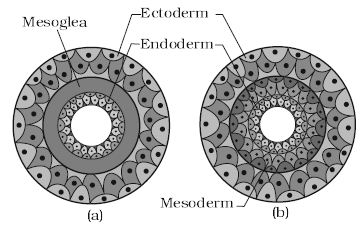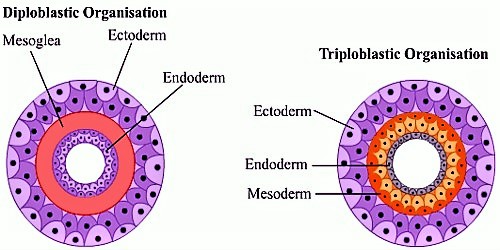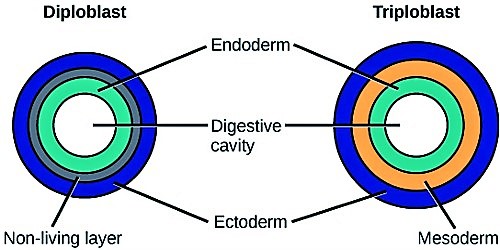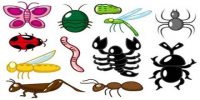Diploblastic: Animals in which the cells are arranged in two embryonic layers, external ectoderm, and internal endoderm, are called diploblastic animals, for example, coelenterates. An animal possessing 2 major tissue layers. These contain the outer layer (the ectoderm) and the inner layer (the endoderm). During gastrulation, diploblastic organisms form a gastrula which consists of two key germ layers. These two germ layers are composed of endoderm and ectoderm but not mesoderm. An undifferentiated layer, mesoglea is present in between the ectoderm and the endoderm (Figure: a).

Triploblastic: An animal possessing 3 major tissue layers. It has a central layer (the mesoderm), between the endoderm and the ectoderm. Triploblastic organisms from all three key germ layers – endoderm, ectoderm, and mesoderm – throughout the gastrulation of the blastula. Those animals in which the developing embryo has a third germinal layer, mesoderm, in between the ectoderm and endoderm, are called triploblastic animals (Platyhelminthes to chordates Figure: b).
Differences between Diploblastic and Triploblastic –
Diploblastic – Animals in which the embryo have two developing tissue layers or germ layers i.e. ectoderm and endoderm are termed as diploblastic. Here, Coelom is absent, e.g. Hydra (coelenterates), sponges (Porifera). Common examples are Sponges, coelenterates and cnidarians, etc.
- Diploblastic animals are primitive metazoans, animals include Cnidarians and Ctenophores, Non- cellular, gelatinous mesogloea is nearby in between ectoderm and endoderm.
- Biological Symmetry – Diploblastic animals are completely symmetric.
- Mesoderm Development: Diploblastic animals are absent a mesoderm. In between endoderm and the ectoderm, mesoglea can be identified. Body wall develops from two embryonic germ layers- ectoderm and endoderms and persists as such an adult.
- Body Cavities: Diploblastic animals do not have body cavities. There is only one cavity in the body. It is called a gastrovascular cavity. It is used for digestion.
- Endoderm Development: Endoderm of the diploblastic animals forms true tissues and the gut.
- Ectoderm Development: Ectoderm of the diploblastic animal’s forms epidermis, nervous tissue, and nephridia.
- Development of Organs: Diploblastic animals do not have organs.
- The complexity of the Organism: Diploblastic animals are not complex.
- There is no particular transport organism in these animals. Transport of material takes within the body by diffusion. There is no central nervous method in these animals. A neuron network is present.
- Animals in phyla Cnidaria and Ctenophora belong to this group. Cnidarians include jellyfish, corals, sea pens, sea anemones, etc., and ctenophores include comb jellies. These simple, primitive metazoans basically lack body cavities and true organs.
- Examples: Jellyfish, comb jellies, corals and sea anemones are examples.

Triploblastic – Animals in which the embryo have three developing tissue layers or germ layers i.e. ectoderm, mesoderm, and endoderm are termed as triploblastic. Here also Coelom is present, e.g. platy-helminths, annelids, arthropods, mollusks, echinoderms, and chordates. Common examples are Mammals, birds, reptiles, etc.
- Triploblastic animals include advanced metazoans, animals include worms, arthropods, echinoderms, mollusks, and vertebrates. Mesogloea is absent and mesoderm is present.
- Biological Symmetry – Triploblastic animals are bilaterally symmetric.
- Mesoderm Development: Triploblastic animals develop a mesoderm. The body develops from 3 germ layers- ectoderm, mesoderm, and endoderms.
- Body Cavities: Most triploblastic animals develop a body cavity, the coelom.
- Endoderm Development: Endoderm of triploblastic animals forms lungs, stomach, colon, liver, urinary bladder, etc. Endoderm forms the lining of the digestive system and forms the glands of the digestive system like liver.
- Ectoderm Development: Ectoderm of the triploblastic animal’s forms epidermis, hair, eye lens, brain, spinal cord, etc. The integumentary (membranous) and nervous systems develop from ectoderm.
- Development of Organs: Triploblastic animals have true organs such as heart, kidney, and lungs.
- The complexity of the Organism: Triploblastic animals are much complex than diploblastic animals.
- They have a special transport system. It is a blood vascular system in most of the animals. Triploblastic animals have complex body structures including coelom or true body cavity and true organs. However, certain triploblastic animals secondarily lost their body cavities, hence called acoelomates.
- Examples: Molluscs, worms, arthropods, Echinodermata and vertebrates are examples.














